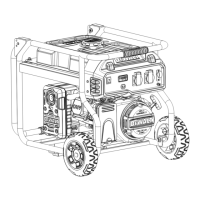SAFETY
4
18. Only use a suitable means of transport and
lifting devices with sufficient weight bearing
capacity when transporting the generator.
19. Secure the Generator on transport vehicles
to prevent the tool from rolling, slipping, and
tilting.
20.
Do not leave the Generator unattended when it
is running. Turn off the Generator (and remove
safety keys, if available) before leaving the work
area.
21. The Generator engine can produce high noise
levels. Prolonged exposure to noise levels
above 8
5 dBA is hazardous to hearing. Always
wear ear protection when operating or working
around the gas engine while it is operating.
22. Wear safety glasses, hearing protection, and
dust mask/respirator during use.
23. People with pacemakers should consult their
physician(s) before use. Electromagnetic fields
in close proximity to a heart pacemaker could
cause pacemaker interference or pacemaker
failure. Caution is necessary when near the
engine’s magneto or recoil starter.
24.
Accessories that may
be suitable for one piece
of equipment
may
become hazardous when
used on another piece of equipment.
25. Do not operate in explosive atmospheres,
such as in the presence of flammable
liquids, gases, or dust. Gasoline-powered
engines may ignite the dust or fumes.
26. Keep grounded conductive objects, such as
tools, away from exposed, live electrical parts
and connections to avoid sparking or arcing.
These events could ignite fumes or vapors.
27. Stay alert, watch what you are d
oing and
use common sense when operating this
piece of equipment. Do not use this piece of
equipment while tired or under the influence
of drugs, alcohol or medication.
28. Dress properly. Do not wear loose clothing or
Jewellery. Keep hair, clothing and gloves away
from moving parts. Loose clothes, jewellery or
long hair can be caught in moving parts.
29. Parts, especially exhaust system components,
get very hot during use. Stay clear of hot parts.
30. Do
not cover the generator or its engine
during operation.
31. Keep the generator, its engine, and surrounding
area clean at all times.
WHEN STARTING EQUIPMENT
DO NOT
crank engine with spark plug removed.
Generator voltage could cause electrical
shock or burn resulting in death or serious
Use approved transfer equipment, suitable for the
intended use, to prevent backfeed by isolating
generator from electric utility workers.
Ensure spark plug, muffler, fuel cap, and air cleaner
are in place.
Turn generator engine OFF and let it cool at least
2 minutes before removing fuel cap.
Loosen cap slowly to relieve pressure in tank.
Fill or drain fuel tank outdoors.
Keep fuel away from sparks, open flames.
Check fuel lines, tank, cap, and fittings.
If fuel spills, wait until it evaporates before starting
engine.
DO NOT
overfill tank. Allow space for fuel expansion.
Fuel and its vapors are extremely flammable and
explosive which could cause burns, fire, or explosion
resulting in death or serious injury and/or property
damage.
WHEN ADDING OR DRAINING FUEL
DO NOT
light a cigarette or smoke.

